Amazon ends its AmazonSmile program
March 9, 2023
February marked the last days of Amazon’s donation program AmazonSmile, which the company announced it would be ending a month earlier on January 25, 2033. Started in 2013, the AmazonSmile program offered nonprofit organizations to opt in, allowing customers to donate 0.5% of proceeds from their purchase to a charity of their choice.
Amazon explained that the program was ending because it did not grow enough to have the impact they originally intended. The program supported millions of different nonprofits, causing the company to feel resources were being spread too thin. The company has decided to instead redirect its resources to larger organizations, where they believe they could make more meaningful change.
as Amazon closes #amazonsmile I am going to have to rethink how I utilize @amazon going forward. The donation to my favorite rescue was the best motivation to choose Amazon. Yes, it’s convenient but it will no longer be my go to. Ending #amazonsmile makes me so sad.
— EverythingCounts ???♥️☺️??#RESIST (@gym48127) February 28, 2023
In their official statement, Amazon provided some specifics as to the larger organizations it would be redirecting its resources to. While Amazon donated to these organizations before the shift, they will now be able to contribute even more money to them. These organizations include the Housing Equity Fund, the Amazon Future Engineer program, the Community Delivery program, the Amazon Disaster Relief program, and the community giving program. Each of these organizations and programs attempts wide-scale change, with many working with several different nonprofits to enact their mission.
Amazon also provided a final donation to every nonprofit organization that had opted in to the program in order to ease the transition. Each organization received a donation that was equal to 25% of the amount it earned from the program in 2022.
While this donation was intended to ease the transition, many non-profits were still disrupted by the end of the program. The resources each nonprofit gained from the program was relatively small compared to the amount of profit being made by Amazon. Many only gained a couple of thousands of dollars from the program. However, for many nonprofits, particularly smaller ones, even a small donation made a noticeable difference in their funding.
This tangible difference was especially noticeable during times when nonprofits were strained and resources were more limited — particularly during the Covid-19 pandemic. Many nonprofits were responding to greater needs in their communities while simultaneously dealing with decreased resources.
One such nonprofit was the Community Food Pantry in Carrollwood, whose resources were particularly strained during the pandemic as they responded to an increase in food insecurity in the Tampa Bay area.
“We are sad to see the AmazonSmile program stopped by Amazon. I am sure that other nonprofits feel the same way as it sustained many during tough times,” said the pantry’s director Monica Wilson.
In total, the program had raised $400 million by its end. However, the impact of the program was limited by a number of factors. As Amazon cited, resources were spread across over 1 million nonprofits. Larger, more well-known organizations were able to spread their message the most, and thus benefit the most. For instance, the ASPCA, one of the most recognizable charities in the US, made $15 million from AmazonSmile donations throughout the program’s run. Conversely, smaller nonprofits, who may have had the greatest need for donations, benefited the least. Many only received a couple hundred dollars throughout the program’s duration.
Thanks to our extraordinary supporters, we have received over $15 million from #AmazonSmile to help the nation’s most vulnerable and victimized animals! We are extremely honored and this would not be possible without supporters like you! Read more here: https://t.co/kVLFlIXEVJ pic.twitter.com/Q7zB07K1wZ
— ASPCA (@ASPCA) November 15, 2022
This lack of funding was also because a very small percentage of proceeds were donated through the program, with only 50 cents being donated for every $100 spent. Amazon did not increase this percentage at any point from 2013, even during times of need like pandemic. The percentage also did not fluctuate during the economy, meaning it did not increase during times of high inflation.
Additionally, many customers did not opt in to the program, leaving a portion of proceeds unclaimed. Customers had to go specifically to the AmazonSmile website, rather than going through the default Amazon portal. This extra step likely caused many to fail to participate in the program, meaning charities missed out on potential donations.
While the above issues prevented the program from having as large of an impact as intended, many have still been critical of the choice to end the program. Amazon is extremely profitable, making $514 billion in 2022. This has led many to believe that Amazon could continue the AmazonSmile program, since it makes up a small portion of its total revenue, while contributing larger amounts to larger nonprofits. Thus, the largest number of nonprofits possible would be able to benefit from the massively successful company.
Spark Good Round Up’s Million Dollar March is teaming up with customers and nonprofits to give away $1M to causes around the country. Learn more about how we’re matching donations supporting nonprofits from now until March 31. #WalmartSparkGood https://t.co/JTBlJOIrVK pic.twitter.com/ZX80jKTenq
— Walmart Inc. (@WalmartInc) March 1, 2023
The end of the program has not created a complete void in the world of corporate charity. Amazon’s competitor Walmart launched its own donation program, Spark Good, last year. Customers can contribute to a nonprofit of their choice through Walmart’s online store, and can buy goods from their online registry. Unlike AmazonSmile, customers can round up their payment to the nearest dollar to donate.
“Through leading a Rose Project, I was able to learn a little bit more about the costs associated with service and trying to operate a nonprofit. I think these programs are really important because money is necessary to run a charity successfully and help it do the most it possibly can,” said Julia Lombardi (’23).

